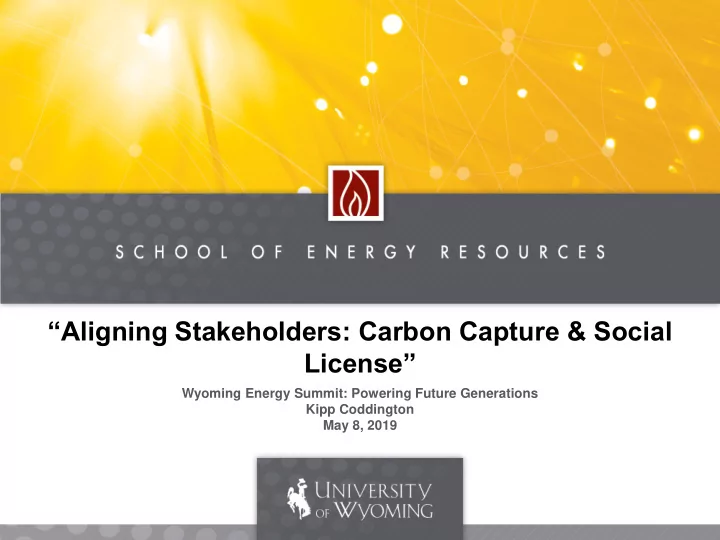

“Aligning Stakeholders: Carbon Capture & Social License” Wyoming Energy Summit: Powering Future Generations Kipp Coddington May 8, 2019
Presentation Overview ✓ Wyoming CarbonSAFE Feasibility Study ✓ Why the University of Wyoming (UW) is Engaged in CCS/CCUS & Related Research ✓ Musings Regarding the “Energy Transition” ✓ What UW is Doing to Help the State on These Topics ✓ Possible Defense/Offense Policy Strategies for Wyoming
Wyoming CarbonSAFE Project Community engagement is a key aspect of the endeavor. Image Credit: Scott Quillinan
Why the University of Wyoming is Engaged in CCS/CCUS & Related Applied Research ✓ Wyoming exports most of its energy ✓ Carbon reductions are the law & otherwise deeply engrained in policy/society ✓ CCS/CCUS are specifically recognized by the U.S. Environmental Protection Agency and key states such as California as low-carbon compliance pathways for all fossil fuels, with robust regulatory regimes in place ✓ The State of Wyoming’s leadership on CCS/CCUS is remarkable and beneficial
Musings Regarding the “Energy Transition” ✓ No universally accepted definition ✓ “Energy transitions” generally require a specific sequence of events -- ❑ Key conceptual breakthroughs ❑ Technical innovations ❑ Organizational actions in specific economic, political and/or strategic circumstances “ I think it is wrong to ✓ Transitions can be lengthy if – presuppose that every ❑ One or more of the events above is missing fossil fired plant is on ❑ The incumbent fuel(s) is entrenched deeply in society its last leg ” – Judith ❑ The society is complex Lagano, SVP, Asset Management, NRG Energy Sources: Smil, V. “Energy Transitions: Global and National Perspectives” (2d ed. 2016); “Illinois Weighs Novel Approach to Quitting Coal” (E&E News, May 7, 2019)
What UW Is Doing to Help the State on These Topics • Low-carbon fossil (CCS, CCUS, BECCS) ✓ “Energy transitions” generally • Advanced combustion (e.g., flameless oxy-combustion) require a specific sequence of • Non-Btu products (Carbon events -- Engineering) ❑ Key conceptual breakthroughs • Many others + renewables ❑ Technical innovations (REE’s, grid -scale storage) ❑ Organizational actions in specific economic, political and/or strategic • New interdisciplinary energy circumstances policy initiative that leverages expertise in economics, business, law, technology & • policy Read: “Social License” • • Regulatory tracker & more Community engagement key part of our grants
Possible Policy Strategies for Wyoming ✓ Inside Our Borders, Inward Facing: • Don’t give up the fight for coal, but take a hard -look at what is happening around us • Take a look at the challenges facing oil and natural gas, too • Expand sustained support for ongoing low-carbon projects (e.g., CarbonSAFE, Carbon Engineering, flameless oxy- combustion, other) & infrastructure (e.g., ITC) • Pursue potential new opportunities (e.g., grid-scale storage) that could have commercial relevance and economic benefit for Wyoming: diversification is imperative ✓ Inside Our Borders, Outward Facing: • Convene & take stock of all energy resources, both fossil & renewable; and look over the horizon to consider what might also be possible (e.g., grid- scale storage; REE’s for renewable energy systems; uranium for a revived nuclear industry) • Assess energy resources by common metrics (e.g., capacity, export markets, economics) then, where feasible and helpful, benchmark them based on carbon intensity or other low-carbon attributes (current and possible) • Analyze what other States are doing (e.g., Illinois, South Carolina) vis-à-vis low-carbon policies • Develop specific low-carbon policy strategies that work for Wyoming ❑ New regulatory models (WPSC, WOGCC, WDEQ, other) ❑ Definitions of “clean” that include CCS/CCUS, high -efficiency ❑ Resource pricing metrics that take into account other attributes (e.g., reliability) ❑ Model State statutes & regulations ❑ Social License
Possible Policy Strategies for Wyoming ✓ Regionally (Pacific NW + Rocky Mountains) + States/Markets Utilizing Wyoming Energy: • Examine the “Colorado” Approach”: decarbonizing domestically but signaling it still needs fossil energy • Building off of CarbonSAFE and other initiatives, develop – and thereafter export – business, finance & regulatory models for CCS/CCUS and other low-carbon projects and technologies ✓ Nationally: • Engage on the low- carbon energy & related energy bills to ensure Wyoming’s interests are protected ✓ Internationally: • The Paris Agreement’s “Rulebook” is set to be completed at COP25 in Chile in December 2019 • A key remaining unknown is the fate of the Article 6 Market Mechanisms; Article 6 has the potential to help CCS/CCUS • Wyoming should consider engaging on these topics
The Existing Coal Fleet: An Initial Opportunity for a Wyoming Policy Approach? Source: “The Coal Cost Crossover: Existing Economic Viability of Existing Coal Compared to New Local Wind and Solar Resources” (Energy Innovation, March 2019) (available at https://energyinnovation.org/wp-content/uploads/2019/03/Coal- Cost-Crossover_Energy-Innovation_VCE_FINAL.pdf)
Q&A For More Information: Kipp Coddington Director, Energy Policy & Economics School of Energy Resources University of Wyoming Laramie, WY kcodding@uwyo.edu Ph: (307) 766-6731 Cell: (703) 628-3950
Recommend
More recommend